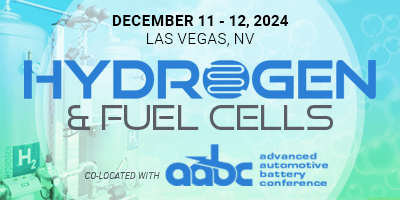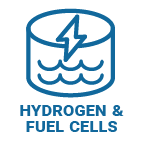Cambridge EnerTech’s
Hydrogen & Fuel Cells
Hydrogen Fueling a Zero-Emissions Future
December 11-12, 2024
Wednesday, December 11
PLENARY KEYNOTE
How GM Is Driving Battery Development and Enabling an All-EV Future
 Kurt Kelty, Vice President, Battery Cell & Pack, General Motors
Kurt Kelty, Vice President, Battery Cell & Pack, General Motors
GM has established a foundation to accelerate the investment in and development of battery technology with a robust supply chain to support its growth over the next decade. In this talk, Kurt will discuss GM’s strategies for investing in new technologies and how its in-house capabilities enhance those efforts, with an overview and rationale behind key investments made to date. He will also provide insights on the company’s approach and significant milestones moving forward.
Steps to Increase EV Sales with V2G Enabled Battery Packs
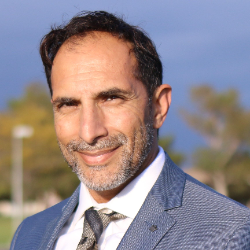 Anil Paryani, Executive Engineering Director, Advanced EV Program, Ford
Anil Paryani, Executive Engineering Director, Advanced EV Program, Ford
Electricity prices are rising faster than gasoline. Simultaneously, clean solar energy is becoming available but remains underutilized. EV sales growth is flat. Why not charge EVs with excessive solar and then support the grid in times of challenge? Government policy and battery cycle life hinder the rollout of existing vehicle-to-grid (V2G) technology. This paper explores necessary electricity price changes and battery cycle life requirements needed to increase EV sales growth.
How Redwood Materials Is Building a Sustainable Battery Supply Chain
 Colin Campbell, CTO, Redwood Materials
Colin Campbell, CTO, Redwood Materials
Redwood Materials is building a domestic supply chain for battery materials that reduces the environmental impact, costs, and supply chain risks of lithium-ion batteries. With the rise of electric vehicles and clean energy technologies comes both a challenge and opportunity to recover these materials, which can be nearly infinitely reused, to sustainably build tomorrow’s lithium-ion batteries. In his talk, Colin will discuss Redwood’s technology and commercial strategy, highlighting the company’s Nevada campus which today is recycling the equivalent of 250,000 EVs worth of material a year and manufacturing cathode active material in the U.S. for the first time.
12:15 pmRoaming Networking Lunch in the Exhibit Hall
1:15 pmDessert Break in the Exhibit Hall with Poster Viewing (Sponsorship Opportunity Available)
FUEL-CELL VEHICLES
Real World Experience of Operating Class 8 FCET (Hyundai XCIENT)—A Technical and Social Impact Analysis
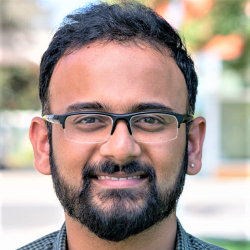 Vishnu Vijayakumar, PhD, Senior Engineer, ZEV Energy & Infrastructure Strategy, Commercial Vehicles Hyundai-Kia America Technical Center, Inc.
Vishnu Vijayakumar, PhD, Senior Engineer, ZEV Energy & Infrastructure Strategy, Commercial Vehicles Hyundai-Kia America Technical Center, Inc.
This presentation provides a comprehensive analysis of the technical and social impacts based on real-world operations of the Hyundai XCIENT Class 8 FCET. It examines performance metrics, operational challenges, and societal implications, offering insights into the future of hydrogen fuel cell electric trucks.
Fuel-Cell-Powered Emergency Vehicle
 Nicholas M. Josefik, Mechanical Engineer, US Army Construction Engineering Research Lab
Nicholas M. Josefik, Mechanical Engineer, US Army Construction Engineering Research Lab
H2@Rescue, our zero-emission fuel cell–powered emergency vehicle, is capable of driving 180 miles round trip, providing 25 kW load-following exportable power for 72 hours on a single tank of hydrogen. The boxed bed is climate-controlled and acts as a mobile command center or warming/cooling shelter. H2@Rescue, which produces water for use during the emergency, is a class 7 medium-duty truck weighing ~33,000 lbs. carrying 176kg of hydrogen at 700bar.
Session Wrap-Up
3:25 pmRefreshment Break in the Exhibit Hall with Poster Viewing (Sponsorship Opportunity Available)
HYDROGEN & TRANSPORTATION
Revolutionizing Heavy-Duty Fueling: Cavendish Hydrogen's NextGen Solutions for a Sustainable Future
 Eddy Nupoort, Director of Sales and Business Development, Cavendish Hydrogen Americas Inc.
Eddy Nupoort, Director of Sales and Business Development, Cavendish Hydrogen Americas Inc.
Cavendish Hydrogen will discuss their innovative hydrogen refueling stations and NextGen High-Capacity developments for heavy-duty vehicles, aiming to set a new standard in reliable fueling solutions. With over two decades of experience, their mission is to eliminate emissions and deliver safer, faster, and more dependable hydrogen fueling solutions.
Transportation and Regulations of Fuel Cells
 James E. Powell, President & Founder, Consulting, Transportation Development Group LLC
James E. Powell, President & Founder, Consulting, Transportation Development Group LLC
This presentation explores the transportation logistics and regulatory landscape governing fuel cell technologies. It examines key regulatory frameworks, logistical challenges, and technological advancements shaping the adoption and integration of fuel cells in transportation systems globally.
H2LA - Houston to Los Angeles Hydrogen I-10 Corridor Planning
 Bart Sowa, Research and Development, Manager, GTI Energy
Bart Sowa, Research and Development, Manager, GTI Energy
The project will identify hotspots of potential hydrogen supply and demand along Interstate 10 (I-10) between Houston and Los Angeles with the Texas Triangle Megaregion (Dallas, Houston, San Antonio) as the anchor region. The collaboration with industry partners will ensure that the plan is practical and investment-ready. Because the H2LA Corridor represents a significant portion of freight movement in Texas and between three of the largest U.S. container-handling ports (Port Houston, Port of Los Angeles, and Port of Long Beach), it will be a key component of the regional hydrogen economy.
Session Wrap-Up
5:50 pmClose of Day
Thursday, December 12
8:00 amRegistration and Morning Coffee
HYDROGEN ECONOMY
Innovative Balance-of-Plant (BoP) Components for PEM Fuel Cell Systems
 Michael Harenbrock, PhD, Principal Expert, Engineering Electric Mobility, MANN+HUMMEL GmbH
Michael Harenbrock, PhD, Principal Expert, Engineering Electric Mobility, MANN+HUMMEL GmbH
BoP components are essential to achieve fuel cell system cost, lifetime and energy efficiency targets. As the interest in systems with more than 200 kW power rises, they must be adapted to higher functional requirements. This presentation highlights new solutions for BoP components in cathode air paths and cooling loop of systems with 200 - 400 kW power and provides an overview on new humidifier and anode water separator designs.
Charged Wire Testing for Determining the Insulative Properties of Heat Transfer Fluids
 Jennifer Jenkins, EV Scientist, Valvoline
Jennifer Jenkins, EV Scientist, Valvoline
Heat Transfer Fluids (HTF) are a specific branch of coolants that are designed to heat and cool electric vehicle batteries, fuel cells, battery energy storage facilities, data centers, and many other technologies. The additives in Heat Transfer Fluids are chosen to create semi-insulative environments in case of accidental exposure to a stray current from the electrical circuit or battery unlike traditional coolants.
10:45 amCoffee & Bagel Break in the Exhibit Hall with Poster Viewing (Sponsorship Opportunity Available)
ELECTROLYSIS
Enhanced Water Electrolysis Using Layered Coaxial Nanowire Electrodes
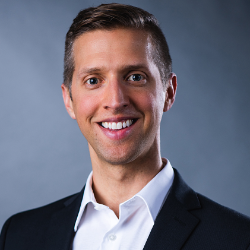 Jacob S. Spendelow, Scientist, Los Alamos National Laboratory
Jacob S. Spendelow, Scientist, Los Alamos National Laboratory
To enhance hydrogen production efficiency in PEM water electrolyzers, the innovative Layered Coaxial Nanowire Electrode (LCANE) has surfaced. LCANE electrodes incorporate vertically-aligned coaxial nanowires adorned with Pt and IrO2 clusters on the Pt shell, improving electronic conductivity and transport efficiency. Remarkably, LCANE achieves a significant reduction in Ir loading, as low as 0.1 mg/cm², without compromising performance, offering a compelling avenue for advancing PEM electrolysis technology.
PEM Electrolyzers
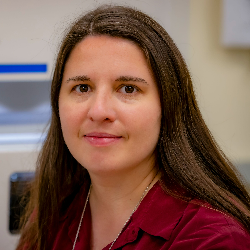 Iryna V. Zenyuk, Professor, Chemical & Biomolecular Engineering, University of California Irvine
Iryna V. Zenyuk, Professor, Chemical & Biomolecular Engineering, University of California Irvine
US Department of Energy (DOE) has issued Hydrogen Shot aiming to produce 1 kg of hydrogen for $1 in 1 decade (by 2030). Proton exchange membrane water electrolyzers (PEMWEs) are promising technologies and are considered to dominate the electrolysis market. This work will focus on materials design and integration needs to reach GW-scale electrolyzer deployment. I will discuss materials and system-level challenges and strategies to overcome them.
A Poly-Generative ICE/Electrolyser System to Support the Green Mobility in a Countryside Building
 Giuseppe De Lorenzo, PhD, Department of Mechanical Engineering, University of Calabria
Giuseppe De Lorenzo, PhD, Department of Mechanical Engineering, University of Calabria
This study is focused on the energy analysis of a poly-generative system, integrating and Internal Combustion Engine (ICE) fed by syngas produced by the gasification of woody biomass.and an electrolyzer fed by renewable energy, for the sustainable energy generation to support the new green mobility in a countryside building.
Applications of Fuel Cells for the Synthesis of E-Fuels
 Jaroslaw Milewski, PhD, Assoc Prof, Power Engineering, Warsaw Univ of Technology
Jaroslaw Milewski, PhD, Assoc Prof, Power Engineering, Warsaw Univ of Technology
In his presentation, Prof. Jaroslaw Milewski from Warsaw University of Technology explores the use of High Temperature Fuel Cells for synthesizing e-fuels, emphasizing their high thermodynamic efficiency, particularly with methane. The talk highlights ongoing research aimed at improving fuel cell performance through enhanced carbon and sulfur tolerance, and optimizing hydrogen-rich gas production. This presentation underscores the pivotal role of fuel cells in the sustainable production of e-fuels, contributing to the transition towards cleaner energy systems.
Session Wrap-Up
1:05 pmCasual Networking Lunch
CLOSING PLENARY PANEL DISCUSSION
U.S. Post Election EV Landscape: Opportunities & Illusions
Christina Lampe-Onnerud, PhD, Founder and CEO, Cadenza Innovation
With the turbulent U.S. presidential elections now over, what are the implications for the global battery industry and what are the prospects for growth going forward. As the world transitions to electrification, many challenges and market corrections lay ahead. This panel of experts will discuss forecasts and insights about opportunities, challenges, barriers, and key factors shaping the EV roadmap and where the industry is going in the near and long term.
4:45 pmClose of Conference
